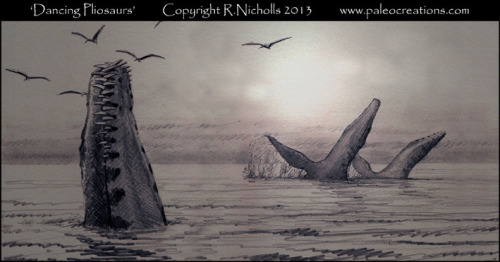#cryptoclidus
Pliosaurs by Robert Nicholls |Follow on Tumblr.
1· Escaping the Odds (Leicester New Walk Museum)
The first Liopleurodon attacked the Muraenosaurus from below and behind. In this ambush the Liopleurodon, a pliosaur, tore away half of a forelimb. But the smell of blood in the water attracts a second nearby Liopleurodon, and the following confrontation will allow the Muraenosaurus, a plesiosaur, to escape!. PRINTS
2· Leviathan (Museum of Jurassic Marine Life)
The greatest predators in the Jurassic oceans were pliosaurs, some of which grew over 12m in length. Here an enormous Pliosaurus lunges forward to capture and swallow a Cryptoclidus whole. Above this attack are four large fish, called Pachycormus, and below swim ammonites, Pectinates, and a shoal of belemnites, Belemnoteuthis.PRINTS
3· Dancing Pliosaurs
At dusk, two pliosaurs dance while a third takes advantage of a pterosaur cleaning station. The pliosaurs and pterosaurs are no particular species; I just thought it was a nice idea that I hope to paint one day soon (in future I might try to make my sketches more species specific). And I realise the low sun may attract criticism because of the sunset cliché, but I figure every place on Earth (except the poles) has a sunrise and a sunset every 24 hours so they are very frequent events.
4· Jurassic Red Tide (Private commission)
A paleoartwork with an abstract expressionist twist! Here a Liopeurodon ferox is swimming amongst a bloom of red algae near a coastal coral reef. This was rendered using photographs, digital painting, and an acrylic painted scale model of Liopleurodon.PRINTS
Post link
Cryptoclidus – Middle Jurassic (166-164 Ma)
We’re not out of the ocean quite yet. Marine fauna are my favorite, so we’re going to cover another example today, and a quite different one at that. Say hello to Cryptoclidus!
The Jurassic began not long after Pangea had begun to break up. Because of the way the continents separated, water currents were able to flow much more uniformly across the earth, which meant a much warmer planet. There isn’t even any evidence for ice caps at the poles, although that isn’t too unusual for prehistoric earth.
This all provides some context for what Cryptoclidus’ Europe looked like. Europe was pretty much unrecognizable during the Jurassic. It was a collection of small-to-midsized islands in a shallow part of the Tethys Sea. It was, like the rest of the world, warmer than it is today. Cryptoclidus lived in these shallow seas, paddling gracefully near the island coasts. It may have even dragged itself onto beaches, but there’s a lot of debate surrounding that. Especially given evidence that plesiosaurs, like other marine reptiles, might have given live birth. If they’re able to give birth, what’s the point of leaving the safety of the water?
Cryptocliduswas a plesiosaur, but one with a stockier body than lots of its relatives. It had a short neck and a thick, short tail. Its jaws were packed with skinny, pointed teeth, perfect for catching soft-bodied cephalopods and small fish. They probably also swallowed rocks for ballast, like their cousins have been found to do.
And, yeah, I’m going to talk about the elephant in the room a little bit. Cryptoclidus did live alongside, and was probably eaten by, its larger cousin Liopleurodon.Liopleurodon is an animal of many misconceptions, but that’s a paleoart for another day.
But back to something a little more pertinent, something that was figured out pretty recently, and something Ihad never considered, is plesiosaur locomotion. How did they swim? The only living animal with four flippers is the sea turtle, and they only paddle their front flippers to swim. There were two main schools of thought. The first was that they paddled all four flippers at the same time. The second said that, no, they alternated, raising their hind flippers when their front flippers were lowered.
So, how did they solve this problem? The same way you solve your problems, obviously: with a plesiosaur robot. They tested a variety of different flipper movements, and found the most efficient was actually in the middle somewhere. They would pump their front flippers, with their hind flippers following soon after. It’s things like this that make this science my passion. It’s really fascinating how many different methods paleontologists use to better understand long-gone animals, especially when all we have to go off are their skeletons, or even just their imprints in rocks. It’s so symbolic of the human ability to solve problems.
Plus, prehistoric animals are really fucking cool.
That about does it for today’s animal. I chose Cryptoclidus because someone very near-and-dear to me suggested I talk about marine reptiles. And of course, Cryptoclidusis featured as the representative of Plesiosaura in Walking with Dinosaurs. Like I’ve said on this blog before, I grew up with the series, and I love it to death. I was really tempted to give Cryptoclidus the brown speckled coloring it has in Walking with. Although, I wasn’t very good at resisting, since I took some cues from their coloration of Opthalmosaurus. Cruel Sea is my favorite episode of the series, so don’t be surprised if I end up drawing every animal from it. I’ve already got myself thinking about Liopleurodon…
Post link




